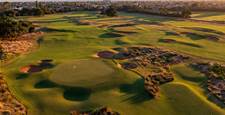Stretching east from the outer suburbs of Melbourne to the New South Wales border, north to the Great Dividing Range and south to the Bass Strait coastline, Gippsland incorporates snowfields, old growth forests, rolling green pastures, beaches and lakes.
Mirboo North Golf Club is a hilly course that, in 1972, was laid out to closely follow the natural terrain. Carved from majestic stands of gum trees, this par-70 is a fun golf course. The surrounds of each hole will impress, as will some of the holes that are very natural in appearance. The first of the highlights comes at the 2nd tee, which sits high above the fairway beyond. The 332-metre par-4 2nd hole is completely ringed by bushland as it rises gradually to the green, which lies in a natural amphitheatre created by tall timbers and a steep grade.
Just beyond the crest of the hill to the left is the 7th green and 8th tee. The downhill 381-metre par-4 8th is one of layout’s best. It is a tight driving hole with a fairway that slopes down gradually from the tee before dramatically dropping away beyond the 220-metre mark before rising to an elevated green that is cut into the side of another hill. The best play here is to keep the driver in the bag, position a fairway metal into the right half of the double-dogleg fairway and leave a flat lie for the long approach into the green.
The best hole on the inward nine is the 160-metre par-3 16th, which has been dubbed by the locals as the ‘Plum Pud’ hole because of the upturned bowl shape of the green. The elevated tee sits well above the green, which has been cut out of the surrounding hill.
Mirboo North has accommodation on course with the 1st T Motel adjacent to the clubhouse and just a few metres from the opening hole.

Less than 20 minutes’ drive west of Leongatha lies the Korumburra Golf Club, which similarly to Mirboo North, covers undulating terrain of the lower Strzelecki Ranges and is home to some very memorable holes.
Korumburra’s fairways are lined by huge gums and a wide array of exotic and native trees that really add to colour of the layout. The club also boasts another natural feature – the giant earthworm. These worms can grow to more than 1.5 metres and are located only in this area of the Gippsland region and nowhere else in the world.
This is a short par-70 at 5,529 metres but the dramatic topography adds plenty of length to many holes.
But length is not an issue on the opening hole, a 123-metre steep downhill par-3, which is ranked as the easiest hole on the course. Nor does it come into play on one of the quality inward holes – the 295-metre par-4 14th. The tight driving hole is made even narrower by the long branches of trees reaching in from the edges of the fairway. A fairway metal or long iron is needed to find the fairway and leave a short club approach into the elevated green where only the top of the flag can be seen and that is only when the cup is cut in the front half of the green. This makes it tough to get any pitch shot close to the hole.
The smallest of the golf towns in close range to Leongatha is Meeniyan, about 15 minutes’ drive south. The population of the town was just 770 back in 2016, yet it still is able to support a picturesque and enjoyable golf course on its outskirts.
Meeniyan Golf Club dates back to 1956 when it was nine holes and sand scrapes with sheep grazing the fairways. The club bought additional land from neighbouring farmer Jack Hughes and opened an additional nine holes for play in 1969.
Stony Creek, which flows through the course and some wetlands, not only provides a home for nearly 25 species of birdlife and three different types of frogs, but it adds to the excitement of several holes.

The Toonallook wetland area was added to the bottom of the hill on front of the 18th tee several years ago. Its presence can tighten the grip of any player who is faced with having to hit a good drive up the hill on the 384-metre par-4 closing hole. Ideally, the drive needs to find the left half of the fairway as trees encroaching from the right edge of the fairway can block out your long approach to a small green lying in front of the clubhouse.
Meeniyan is one of the easier walking courses in the region and its small greens really place a premium on accuracy if you are to make a good score.
Heading further east from Meeniyan, following the A440 for nearly an hour, you’ll find Yarram, which lies at the heart of a rich farming district and is a short drive from the famous Ninety Mile Beach.
Not unlike Meeniyan, Yarram has a relatively small population to draw its members from and there is a great reliance on volunteer assistance. Those Victorian golfers in the know rate Yarram Golf Club as a true hidden gem of the Gippsland region.
The results of the tender loving care provided by the members are superb, well-maintained playing surfaces. The bentgrass greens roll true and speedy, while the Santa Ana couch fairways are like carpets. But venture too far from the clipped grasses and the rough gets, well, pretty rough. Laid out on sand, sandy lies in the rough – just like you were playing in the famous Melbourne Sandbelt – are common.
Yarram has some very good short holes, with one of the best being the 256-metre par-4 9th. Long hitters can blaze away at the green, which is slightly obscured from view to the left when standing on the tee. The conservative play, leaving an approach from the bottom of the hill about 50 metres from the front of the green, is quite difficult because the depth of the green, and a tier running through it, adds guesswork to the shot.
ALONG THE A1
The Princes Highway (A1) weaves across the northern edge of the Gippsland region from Melbourne’s eastern outskirts and eventually crosses the New South Wales border nearly 500 kilometres away.
Warragul, about 45 minutes’ drive east of Dandenong, lies between the Strzelecki Ranges to the south and the Mt Baw Baw Plateau of the Great Dividing Range to the north. It’s here where you will find the biggest club in the west Gippsland area – Warragul Country Club.
The Warragul club, which is home to the PGA Tour of Australasia’s Gippsland Super 6s tournament, was first established in 1907 and has been on its current site since 1927.
The original 18-hole layout was redesigned by George Lowe (who also created the acclaimed Warrnambool Golf Club course) after World War II when land was set aside for housing. Despite some alterations over the years, much of Lowe’s design remains.
The par-71 weaves up and over several hills away from the clubhouse, with the undulating terrain laying the foundation for some interesting and fun holes, with a quartet of front nine holes proving perhaps the most memorable.

Back-to-back short par-4s at the 5th and 6th are genuine birdie chances but there are risks associated with playing them aggressively, especially the 306-metre 5th that is played across a ridge and features a fairway, which narrows significantly the closer you get to the green.
From the back markers, the 173-metre par-3 7th plays downhill from the tee to a green cut into the hillside beneath the 5th fairway. Steep drop-offs around the front of the putting surface ensure if you don’t have the correct club in your hands you will be chipping from well below the green.
The next is arguably Warragul’s toughest test. The 8th is 416 metres from the tips but it plays much longer as the entire journey from tee to green is uphill. Any shots gained over the previous three holes can easily be handed back here.
Warragul’s presentation is also sure to impress, with a good cover of Legends couch on the fairways and bentgrass greens that are among the best in the region.
Related Articles

Touring New Zealand: The complete golfing package












